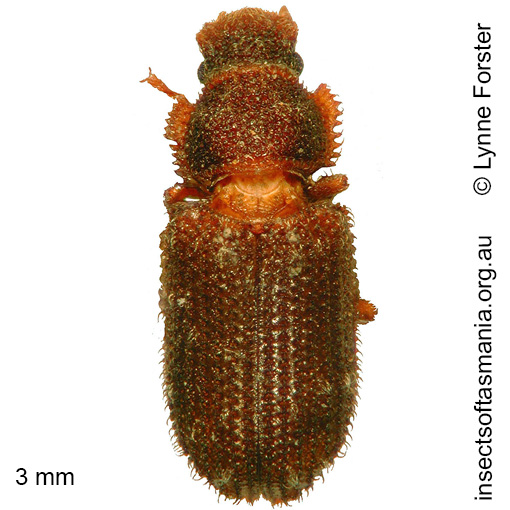
Ablabus obscurus (a species of cylindrical bark-beetle)
Basis for Tasmanian occurrence
Semmens, T.D., McQuillan, P.B. & Hayhurst, G. (1992). Catalogue of the Insects of Tasmania. Government of Tasmania: Department of Primary Industry, 104 pp.
TMAG collections
Classification
Order: Coleoptera
Suborder: Polyphaga
Superfamily: Tenebrionoidea
Family: Zopheridae
Subfamily: Colydiinae
Tribe: Colydiini
Morphology
Typical length (mm): 3
Flightedness: winged and assumed capable of flight
Morphology (characterised by L. Forster): — Antennae with two-segmented club — Head with labial palps absent and with frontal ridges raised above antennae — Pronotum with margins explanate, coarsely serrate.
Source literature on morphology and taxonomy (*primary taxonomic source, where identified):
Carter, H. & Zeck, E. (1937). A monograph of the Australian Colydiidae. Proc. Lin. Soc. NSW 62(3/4): 181-208. [Page 196].
Ecology
Assumed larval feeding: wood-feeder
Association with dead wood or old trees: obligately saproxylic
Collection method(s) for TMAG material: — Hand collection from Eucalyptus pulchella — Knockdown spraying of bark of Eucalyptus sp. — Pitfall trapping — Sticky trapping on Eucalyptus obliqua.
Source ecological literature:
Baker, S.C. (2006b). Ecology and conservation of ground-dwelling beetles in managed wet eucalypt forest: edge and riparian effects. PhD thesis, Univ. of Tasmania, Hobart.
Grove, S.J. & Yaxley, B. (2005). Wildlife habitat strips and native forest ground-active beetle assemblages in plantation nodes in northeast Tasmania. Aust. J. Entom. 44 (4): 331-343.
Harrison, K.S. (2007). Saproxylic beetles associated with habitat features in Eucalyptus obliqua trees in the southern forests of Tasmania. PhD thesis, Dept. of Zoology, Univ. of Tasmania, Hobart.

